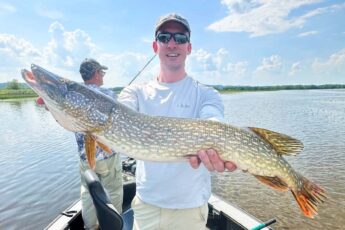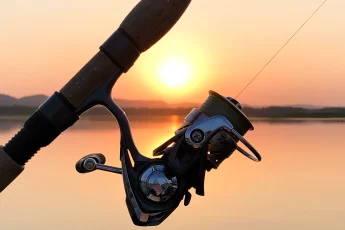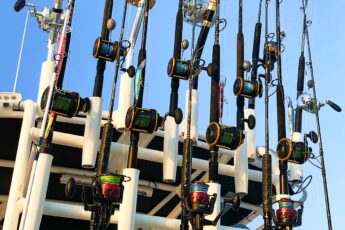
Updated 12/29/2023
The best baitcasting reels for bass should be smooth, durable, reliable, and capable of handling the demands of bass fishing. In this article, we take a look at the top bass baitcasting reels on the market, considering factors like price, performance, quality, and value.
When you hook into the lunker largemouth bass of a lifetime, make sure you have the right equipment for the job!
*Disclosure: I only recommend products I would use myself and all opinions expressed here are my own. This post may contain affiliate links that at no additional cost to you, I may earn a small commission.
Our Top 7 Picks
- Best for the Money: Shimano Curado M
- Best Under $200: Abu Garcia Revo SX
- Best Under $100: KastKing Royale Legend II
- Best Lightweight: Daiwa Tatula 100 TWS
- Best for Beginners: Abu Garcia Revo S
- Best Premium: Shimano Curado DC
- Best High Speed: Abu Garcia Revo Rocket
The 7 Best Baitcasting Reels
Whether you’re a new angler or a grizzled expert, we have you covered. Check out our recommendations for best baitcasting reels for bass by category like best budget, premium, and best high speed amongst others!
1. Shimano Curado M
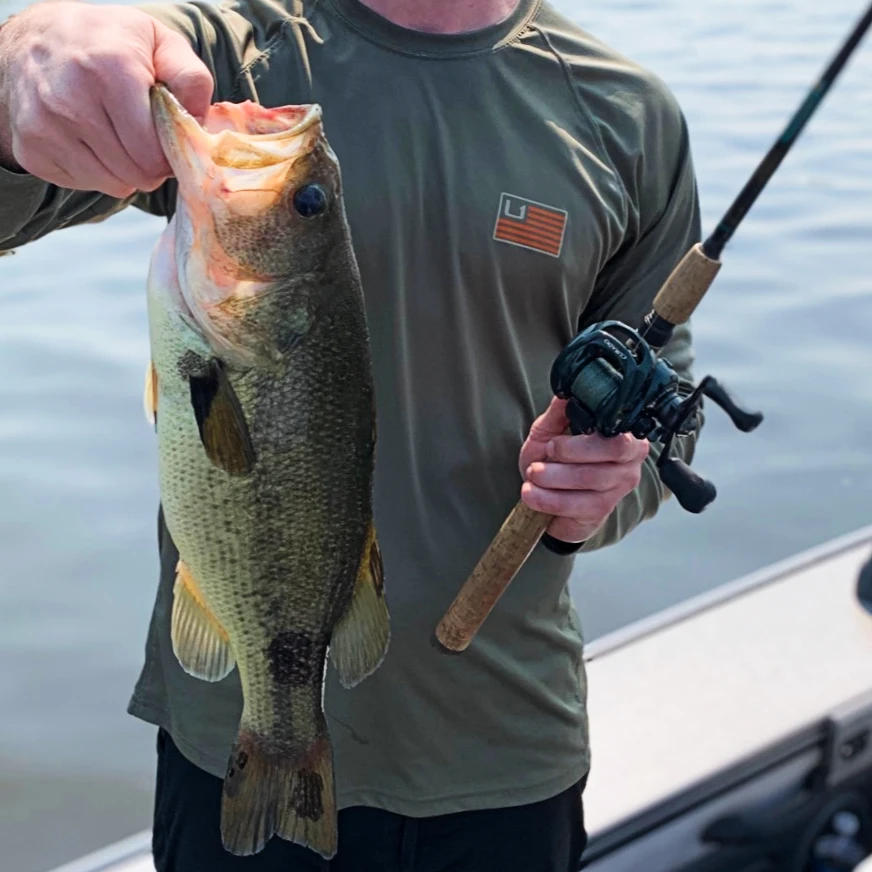
- Gear Ratio: 6.2:1 – 8.5:1
- Max Drag: 12 – 13 lbs
- Ball Bearings: 6+1
- Weight: 7.4 – 7.6 oz
- Braid Capacity (yd/lb): 190/30
Pros:
- Butter smooth
- Great casting distance
- Marketed for freshwater and saltwater
Our choice for best baitcasting reel for bass for the money is the Shimano Curado M. We picked it as our top choice because it’s a no-frills, high value proposition reel.
This reel is smooth as butter and feels like you can cast it a mile. It’s built for reliability and durability, rated for both freshwater and saltwater, and is an absolute delight to fish with.
Shimano recently released the Curado M as their flagship replacement for the Curado K. Compared to the Curado 200K, the Curado 200M is 0.2 oz lighter, has 2 lb higher max drag rating, and has Shimano’s MagnumLite (MGL) Spool III that reduces start-up inertia for unparalleled casting performance. Also, they added the SilentTune technology that reduces spool noise during casts.
The Curado M features Shimano’s latest MicroModule gearing they claim as super smooth and efficient. Spoilers, it is.
The Curado M baitcasting reel can do anything you want a baitcaster to do from finesse bass fishing in thick vegetation to working huge swimbaits in open water.
I could go on and on about this reel. Suffice to say, if you want a smooth, durable, multi-function, long lasting baitcasting reel, the Shimano Curado M is a great choice.
2. Abu Garcia Revo SX
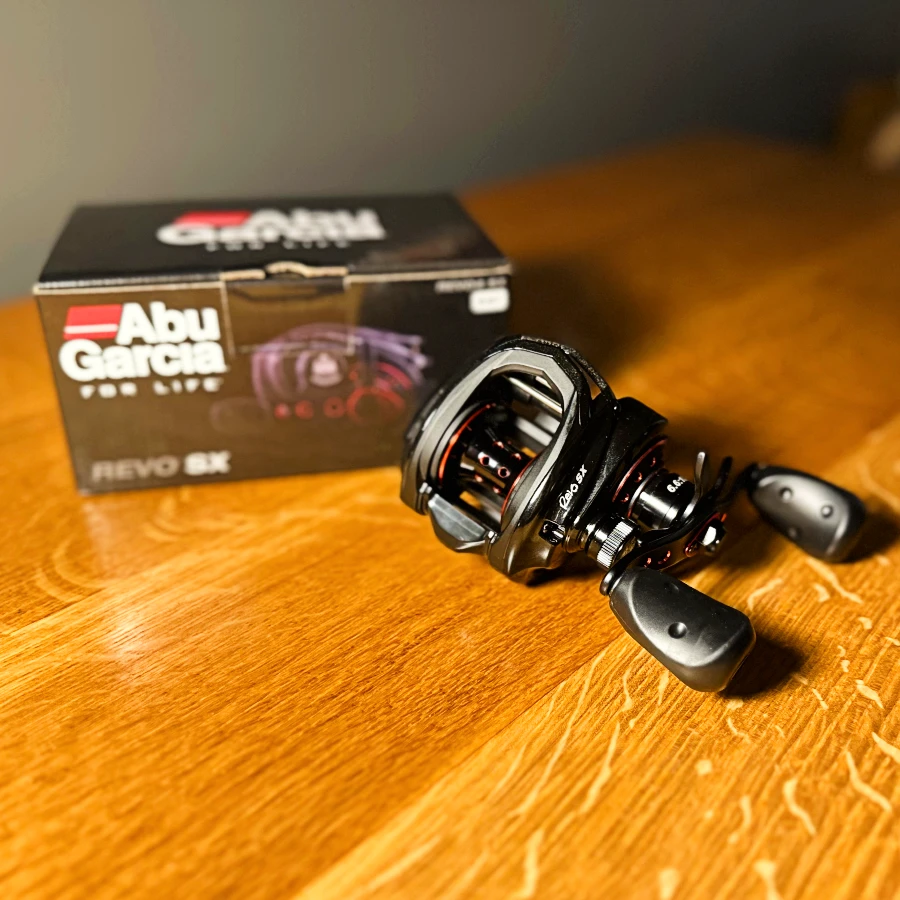
- Gear Ratio: 6.6:1 – 7.3:1
- Max Drag: 24 lbs
- Ball Bearings: 9+1
- Weight: 7.8 oz
- Braid Capacity (yd/lb): 170/20
Pros:
- Premium features at great value price
Our choice for the best baitcasting reel for bass under $200 is the Abu Garcia Revo SX. This is Abu Garcia’s most popular baitcasting reel for good reason. It’s lightweight, smooth, and a workhorse bass fishing reel.
It includes a number of Abu Garcia’s technologies like the easily adjustable magnetic Infini brake system and ultra-smooth 9+1 ball bearings.
The reel comes in both 6.6:1 and 7.3:1 gear ratios. Grab the 6.6:1 for great all-purpose bass fishing. Grab the 7.3:1 for burning topwaters or when you need to get a bunch of casts in with flipping and pitching.
Similar to our top choice, this is a great value option baitcasting reel that will last forever and is a delight to fish with.
3. KastKing Royale Legend II
- Gear Ratio: 5.4:1 – 7.2:1
- Max Drag: 17.6 lbs
- Ball Bearings: 5+1
- Weight: 7.2 oz
- Braid Capacity (yd/lb): 130/40
Pros:
- Budget Price
Our choice for the best baitcasting reel for bass under $100 is the KastKing Royale Legend II. This reel is a great option for anglers on a budget or a no-regrets first try at using a baitcasting reel.
The Royale Legend II features a magnetic spool brake, 5+1 ball bearings, and a surprisingly robust construction for a budget priced reel. As expected with a budget option, the action isn’t as smooth as with pricier reels. That said, you don’t need the most expensive equipment to catch plenty of bass.
This is also a great baitcaster for beginners that are budget sensitive. Less than $50 for a solid baitcasting reel is huge value and an awesome way to practice using a casting reel. I would no-shame grab this reel, beat it up practicing, then upgrade to a higher end reel once comfortable with baitcasters.
4. Daiwa Tatula 100 TWS

- Gear Ratio: 6.1:1 – 8.1:1
- Max Drag: 11 lbs
- Ball Bearings: 7+1
- Weight: 6.9 oz
- Braid Capacity (yd/lb): 140/30
Pros:
- Feather-light
- Compact
Our pick for the best lightweight baitcasting reel for bass is the Daiwa Tatula 100 TWS. Coming in at 6.9 oz, this reel is a full ounce lighter than most of the other reels on this list. An ounce may not sound like a lot, but after a long day bass fishing, an ounce may as well be 10 pounds!
This is a great, compact, smooth reel. It features Daiwa’s patented T-Wing system for feeding line and a durable aluminum frame.
The handles are smaller than the other reels on the list. This feature could be important for picking a baitcasting reel for younger anglers or people with smaller hands.
5. Abu Garcia Revo S

- Gear Ratio: 6.6:1 – 7.3:1
- Max Drag: 20 lb
- Ball Bearings: 8+1
- Weight: 8 oz
- Braid Capacity (yd/lb): 190/20
Pros:
- Solid quality at manageable price point
Our pick for best beginner baitcasting reel for bass is the Abu Garcia Revo S. This reel is a no-frills, solidly built, reasonably priced entry point for beginners wanting a baitcasting reel.
Baitcasting reels are an anomaly for ‘beginner recommendations’. Usually we recommend starting with a true budget option, but that isn’t the case for casting reels. The biggest frustration for new baitcaster users is dealing with backlash. There is an unfortunate truth that higher-end baitcasters are EASIER to use and learn with while budget reels can be frustrating and turn anglers off of casting reels.
We landed on the Revo S as a solidly built, mid-tier reel that is a reasonable price. We don’t recommend grabbing the least expensive baitcasting reel as a starting point.
This reel is a good balance. The price point is manageable. The reel itself is solidly built, smooth, and strong.
We will note the reel is marketed for freshwater and probably best used for bass fishing. We took ours saltwater fishing over a two year period and the components did not hold up as well as our higher-end reels. Don’t let that scare you! This reel is a great value proposition for a mid-price baitcasting reel.
6. Shimano Curado DC
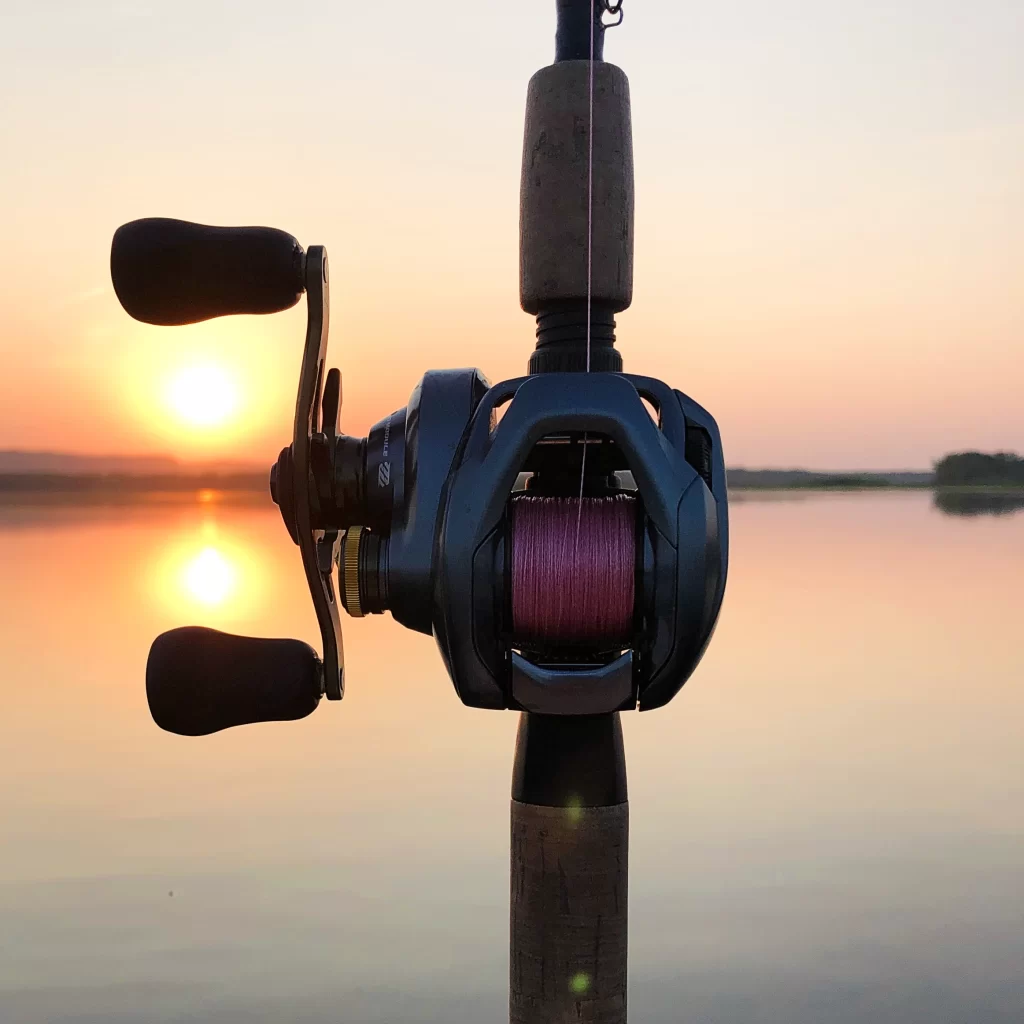
- Gear Ratio: 6.2:1 – 8.5:1
- Max Drag: 11 lbs
- Ball Bearings: 6+1
- Weight: 7.8 – 7.9 oz
- Braid Capacity (yd/lb): 150/20
Pros:
- Digital Control Brake makes it nearly impossible to backlash
Our choice for best premium baitcasting reel for bass is the Shimano Curado DC. Take our glowing recommendation for the Curado baitcasting reel line, slap a microcomputer controlled digital brake on it, and you have the Curado DC.
The Curado DC includes a digital braking system that utilizes a microcomputer to monitor spool speed at a speed of 1,000 times per second. The computer automatically applies the perfect amount of brake to prevent backlash at superhuman speeds. And what’s more amazing? No batteries required!
Backlash is most anglers’ biggest frustration with baitcasting reels. The Curado DC all-but removes the ability for the reel to backlash. Casting into the wind? Light bait? Tried to cast too hard? No problem.
Everything else we’ve said on the Curado reel line still holds true. These reels include high quality components, have butter smooth reeling, and are super reliable.
The Curado DC is an awesome option for a high-end reel. Both beginners and experts alike will appreciate the high build quality and all-but removing the risk of backlash in the heat of the moment.
7. Abu Garcia Revo Rocket
- Gear Ratio: 10.1:1
- Max Drag: 18 lb
- Ball Bearings: 10+1
- Weight: 7.5 oz
- Braid Capacity (yd/lb): 170/20
Pros:
- Screamin’ fast gear ratio
Our choice for best high speed baitcasting reel for bass is the Abu Garcia Revo Rocket. The Revo Rocket has a blazing fast gear ratio of 10.1:1 which equates to a massive recovery rate of 44″ of line for every turn of the reel.
High speed reels are great options for bass anglers that need the ability to quickly burn topwater baits with fewer turns of the reel, take up slack from unexpected bites, or efficiently retrieve between flips and pitches.
For bass anglers that want a super fast retrieving baitcasting reel, they should think about the Revo Rocket.
Reel Comparison Table
Check out our handy comparison table showing key specifications for our top reel choices.
| Reel Name | Gear Ratio | Max Drag | Ball Bearings | Weight | Braid Capacity (yd/lb) |
|---|---|---|---|---|---|
| Shimano Curado M | 6.2:1 – 8.5:1 | 12 – 13 lbs | 6+1 | 7.4 – 7.6 oz | 190/30 |
| Abu Garcia Revo SX | 6.6:1 – 7.3:1 | 24 lbs | 9+1 | 7.8 oz | 170/20 |
| KastKing Royale Legend II | 5.4:1 – 7.2:1 | 17.6 lbs | 5+1 | 7.2 oz | 130/40 |
| Daiwa Tatula 100 TWS | 6.1:1 – 8.1:1 | 11 lbs | 7+1 | 6.9 oz | 140/30 |
| Abu Garcia Revo S | 6.6:1 – 7.3:1 | 20 lb | 8+1 | 8 oz | 190/20 |
| Shimano Curado DC | 6.2:1 – 8.5:1 | 11 lbs | 6+1 | 7.8 – 7.9 oz | 150/20 |
| Abu Garcia Revo Rocket | 10.1:1 | 18 lb | 10+1 | 7.5 oz | 170/20 |
Conclusion
In conclusion, having the right baitcasting reel for bass is essential for a successful day fishing. There are many great options available, but the Shimano Curado M stands out as our best overall choice. This reel offers a balance of performance, durability, and value that makes it a solid choice for any bass angler.
Check out our articles for great rods to pair with these reels:
- Best Bass Fishing Rods
- Best Baitcasting Rods for Bass
- Best Smallmouth Bass Rods
- Best Musky Rods
- Best Flipping & Pitching Rods
- Best Jig Rods for Bass
- Best Frog Fishing Rods
Check out our related reel articles:
Check out our related rod and reel combo articles:
Buying Guide – How to Choose The Best Baitcasting Reel for Bass For You
Key factors for choosing the best baitcasting reel for bass include reel size, brake type, build/material quality, and smoothness.
Line Capacity
Line capacity refers to how much fishing line fits on the reel. The total spool capacity is specified by mono vs braid and line strength as pound test. An example line capacity would be “200 yards of 20-pound test braid”.
Braid is smaller diameter than mono at the same line strength which means you can fit more braid on a reel. Also, higher pound test line is larger diameter and will take up more space on the reel spool.
Line capacity is usually less of a determining factor for baitcasting reels. Most reels in the 100 to 150 size can hold 150-200 yrds of 30 lb braid which is more than enough for most bass fishing applications.
Ball Bearings
Ball bearings in fishing reels are small, spherical bearings that reduce friction and increase smoothness of a reel’s operation. They are located within the internal mechanism of the reel and allow the reel’s moving parts to rotate smoothly against each other.
Most quality reels have at least four ball bearings. More ball bearings is usually better because the higher the number of ball bearings, the more friction is reduced and less wear and tear on the internal reel components. That said, ball bearing quality and material choice are also important. I would rather have four high-quality ball bearings than ten low quality bearings.
Most ball bearings are stainless steel but can also be ceramic. Many reels list something like “5+1 bearings” – this reel would be five ball bearings plus one roller bearing.
Drag System
Drag systems on fishing reels provide resistance to the spool as line is retrieved. A loose drag makes it easier for the spool to spin freely and a tight drag makes it difficult to rotate the spool.
Drag systems work using a series of washers or disks pressed together by a drag knob or level (usually on the top of spinning reels). As the drag is tightened, the drag washers are pressed together which increases resistance on the spool. Drag should be set to match the strength and size of the target fish species.
Setting the drag properly is an art. You want the drag tight enough to reel in the fish, but not too tight to where a strong pull could snap your line or cause your fishing knot to fail. When the drag is properly set, a strong pull from a fish should be able to pull some line from your reel.
A drag rating around 10 pounds is plenty for most bass applications. When using heavy braid for frog fishing or flipping and pitching, 20 pound drag rating is worth thinking about.
Gear Ratio
The gear ratio on a fishing reel refers to the relationship between the number of turns on the spool for every turn of the handle. For example, a gear ratio of 5:1 means the spool rotates five times for every turn of the handle.
Gear ratio is an important consideration when selecting a fishing reel because it affects the speed at which you can retrieve your line. A higher gear ratio is better for situations where you need to reel long distances or require fast bait presentations. A lower gear ratio is preferred for situations where a lower retrieval rate is desired, like when using finesse techniques.
Most reels have a gear ratio between 4:1 to 9.2:1. Many medium size reels are around 6.2:1 gear ratio which is great for most applications. For bass fishing, faster gear ratios like 7.1:1 or higher are great for burning topwaters or quickly retrieving spinner baits. Slower presentation, like crankbaits, are better with lower gear ratios like 5.4:1.
Material Quality
Material quality is an important consideration for picking a baitcasting reel. Fishing reels are typically made of a combination of metal, rubber, and plastic parts. The body of the reel is usually made of aluminum or another type of metal to provide strength and durability. Plastic is used for many of the peripheral parts like the handle or drag knob because it is lightweight and corrosion-resistant.
Rubber seals may be used to protect against water, dirt, and sand ingress. High-end reels may have ceramic bearings or higher quality metal components.
Look for reels made of high-quality materials with solid, durable construction. Be careful bringing freshwater-only rated baitcasting reels to saltwater applications because the materials will corrode quickly. Always rinse with freshwater after saltwater trips.
Reel Brakes
Baitcasting reels have reel brakes. When you make a cast with a baitcasting reel, the momentum of the bait pulls line off of the spool. The spool rotates fastest at the beginning of the cast when forces are the highest. The reel brake slows down rotation of the spool to keep the fishing line tight on the spool and stop a backlash mess.
Brakes are important because if the spool rotates faster than the speed your bait is pulling out line, your reel will become a huge backlash mess.
There are three main types of brakes on fishing reels: centrifugal brakes, magnetic brakes, and digitally controlled brakes.
Centrifugal Brakes
Centrifugal brakes work by using a series of small weights that are pushed outward by centrifugal forces when the spool begins to spin. This increases resistance on the spool. To adjust centrifugal brakes, the side plate must be removed.
Magnetic Brakes
Magnetic brakes work by using a series of magnets to create resistance on the spool. They are considered more precise and higher quality than centrifugal brakes. Magnetic brakes are adjusted by a small dial on the side of the reel and can be fine tuned to adjust the resistance that is applied to the spool.
Digitally Controlled Brakes
Digitally controlled braking system utilize a microcomputer to monitor spool speed. The computer automatically applies the perfect amount of brake at superhuman speed to prevent backlash. Digitally controlled brakes all but remove the ability for the reel to backlash.
Bass Baitcasting Reel Frequently Asked Questions
What kind of reel is best for bass fishing?
Baitcasting reels are best for bass fishing. Baitcasters are easier than spinning reels to accurately cast. They have no line twist and are more comfortable to repeatedly cast with artificial baits commonly used for bass fishing.
What size reel is best for baitcasting?
Baitcasting reels have different size standards between manufacturers. The most common sizing is 100 which is a great all-around size for bass fishing. 200 to 400 size reels are larger and usually for heavier duty fishing like saltwater applications.
What rod to pair with baitcasting reel?
Baitcasting reels should be paired with casting rods. These rods are considered the best for bass fishing because of their casting accuracy compared to spinning rods. Casting rods around 7 feet long with medium power and fast action are a perfect all around choice for a bass fishing rod. Check out our article on the best bass fishing rods available for further reading.
How do you care for baitcasting reels?
Caring for baitcasting reels is important to ensure they perform their best and last a long time. Here are a few tips to take care of your reel:
- Rinse the reel with freshwater after each use to remove any salt, sand, or dirt
- Periodically lubricate the moving parts
- Store the reel properly in a dry protected place when not in use
What strength fishing line for bass baitcasting reels?
Baitcasting reels can use a wide range of fishing line strengths. 8-12 pound braid is great for finesse applications. Frog anglers may increase to 50-65 pound braid to be able to pull big bass out of thick vegetation. Anglers should check the line capacity of their reel to ensure they can fit enough line to fish effectively.
Is mono or braid better for baitcasting reels?
Braided fishing line is preferable for baitcasting reels. Braided line has significantly smaller diameter for the same strength line when compared to mono. This can be key for all kinds of fishing because wind and current will constantly pull at your line. The smaller diameter means less effect from the elements. Additionally, you can fit more braided line than mono on the reel spool.
How to prevent backlash on baitcasting reel?
There are four keys to minimizing backlash on baitcasting reels:
- Set the spool tension knob properly. The spool should be loose enough that the weight of the bait will freely pull line in air. When the bait hits the water, the tension knob should be set so the bait stops pulling line.
- Don’t overdo it with casting power. Trying to whip the bait as hard and as far as possible will increase the likelihood of a backlash.
- Be careful casting light baits into the wind. Strong headwind or crosswind increases likelihood of backlashes.
- Use your thumb to moderate the reel speed during the cast
How to switch baitcasting reel from right to left handed?
Unlike most spinning reels, baitcasting reels are not designed to switch from right to left handed and vice-versa. Baitcasting reels are ordered either right or left handed from the manufacturer.
Low profile baitcasting reel vs round reel
When bass anglers think of baitcasting reels, they usually think of low profile baitcasting reels. These are versatile, compact reels that are perfect for bass fishing. Baitcasting reels also include what are called round reels that are rounder in shape and used more for huge baits and trolling in either saltwater or larger lake fishing.

Written By: Andrew Juran
Andrew is a seasoned angler with over 25 years of experience fishing across the United States. He has caught hundreds of bass using various techniques and mentored many in the art of fishing. An advocate for sustainable fishing, Andrew is an active member of the Coastal Conservation Association, an organization committed to marine conservation.
For frequent fishing tips, behind-the-scenes looks, and real-time catches, connect with Andrew on Instagram






